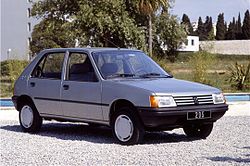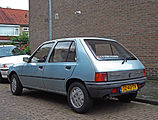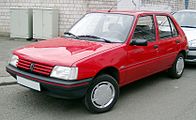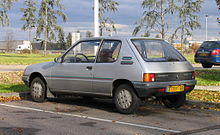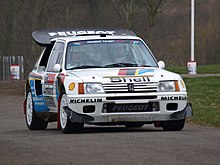Peugeot 205
| Peugeot | |
|---|---|
|
Peugeot 205
|
|
| 205 | |
| Production period: | 1983-1998 |
| Class : | Small car |
| Body versions : | Station wagon , convertible , panel van |
| Engines: |
Otto engines : 1.0–1.9 liters (31–147 kW) Diesel engines : 1.8–1.9 liters (44–58 kW) |
| Length: | 3705 mm |
| Width: | 1572 mm |
| Height: | 1350 mm |
| Wheelbase : | 2420 mm |
| Empty weight : | 720-880 kg |
| Previous model | Peugeot 104 |
| successor | Peugeot 206 |
The Peugeot 205 is a small car produced by the French automaker Peugeot from the beginning of 1983 to the end of 1998 .
history
Development began in 1978 under the project name M24.
On February 24, 1983, the Peugeot 205 came onto the domestic market. From autumn 1983 there was also the diesel variant. The 205 GTI with petrol injection followed in the spring of 1984. In the spring of 1986, the convertible rounded off the model range. With a total of 5,278,000 vehicles, it was a great success for Peugeot. The 205 already received numerous awards in its first year: It was awarded the Golden Steering Wheel , it was named “Best Small Car ” and Car of the Year .
For Group B in racing, Peugeot developed the "205 Turbo 16", a racing car with a tubular space frame, mid-engine and four-wheel drive, which looked similar to the 205 because headlights, indicators, grille, windshield, doors and taillights had been adopted from the 205. With his racing successes he had a certain advertising effect.
In Germany the 205 was the best-selling Peugeot with a total of 410,510 units sold, until its successor 206 overtook it in 2007. In 1985 and 1986 it was the most successful import model in Germany.
In July 1996, however, Peugeot deleted the 205 from its range in Germany, as only just under 600 copies were sold here in the first half of the year and it was apparently no longer competitive due to outdated technology and safety equipment.
Finally, on December 31, 1998, the last 205 rolled off the production line. In the summer of 1998 it was replaced by the 206 model series.
Models
Initially, combinations of two or three letters were used to differentiate the countless model variations from one another, with the facelift these cryptic names were replaced by names that sound like.
Not every model was available in all delivery countries, for example the 205 Trophy was never offered in Germany. In some cases, the scope of equipment also differed: in France, the vehicles were equipped with a catalytic converter relatively late , while it had been installed in models intended for the German market since the mid-1980s. In addition to the three- and five-door sedans, the 205 was built as a convertible by Pininfarina and in two truck versions from spring 1986 .
In mid-1988, the 205 underwent a subtle facelift, which mainly concerned the interior; the cars received modern dashboards right through to the new center console.
A second and more extensive facelift took place in July 1990. The models now differed in various little things: slightly modified taillights, white front indicators and the now rounded housings of the exterior mirrors.
From mid-1992, the lower part of the tailgate no longer had a plastic panel (for example in the special model 205 New Look).
The Peugeot 205 initially only had 13- or 14-inch wheels as standard, from 1988 the 1.3 rallies were delivered with 14-inch wheels. The Peugeot 205 1.9 Gti was the only one to roll off the assembly line with standard 15-inch wheels from 1988.
Letter combinations
The body and equipment variations can be recognized from the letter combinations:
| 1st letter |
|
| 2nd letter |
|
| 3rd letter |
|
| 4th letter | only in connection with D as the 3rd letter
|
Outside of the 205 nomenclature, the automatic version ran with a 1.6-liter engine (53-65 kW) or a 1.9-liter engine (75 kW), power steering (initially only a 1.9-liter engine 1991 also with 1.6 l engine 65 kW), XS instrumentation (temperature display and from 1991 model onwards rev counter and digital clock), lockable and illuminated glove compartment, map reading lamp, velor seats. Outwardly, the 205 Automatic and the 205 "XS90" with 1.6-liter engine were particularly recognizable by their distinctive bonnet, which had a significant increase in the middle part (and was probably initially necessary for reasons of space for the double carburetor). The 4-speed automatic transmission was developed with the help of the ZF company and was installed in parallel in some other PSA vehicles (e.g. Citroën BX etc.), each translated differently.
There was a first noticeable facelift in mid-1988. It was characterized by a new dashboard (more robust), thicker round levers for indicators, lights, windshield wipers, rounded exterior mirrors and a revised tailgate (with the XS / GT / GTI with an integrated small spoiler lip). With this revision, the “Green” variant appeared as a continuation of the limited special model “Lacoste” (only 44 kW engine) with 44 and 55 kW. Even before the second facelift in 1990 (white front indicators, new taillights) the basic "E" models were replaced by "special models". Other "special models" followed. Other models, which are not really special models because they were not limited, are:
- Color Line : red-green stripes on the sides of the vehicle and on the seats (slimmed-down XR / GR)
- Gentry : (75 kW), full leather with sports seats, leather steering wheel black or beige impala, leather gear knob (only with manual transmission), glass sunroof depending on the market, mirror heating, servo, ABS depending on the market, metallic paint in Sorrento green or Mayfair beige (including beige belts) , Wooden inlays in the doors, high-quality velor carpets including trunk, central locking with IR remote control, illuminated makeup mirror, special SMR light alloy wheels 5.5x14 ″ with 185/60 R14H tires in silver or in the beige version in light gold, optional: 4-speed automatic transmission, air conditioning (not offered in Germany)
- Green : vehicle color (including bumper) white, interior green with seat belts, panoramic roof
- Junior : jeans blue seats
- Look : particularly simple equipment (e.g. without a timer)
- Roland Garros : body color green metallic, seats in partial white leather, 55 kW motor, panoramic sliding roof, also as a convertible (convertible with electric roof)
- Winner: Sports seats and sports steering wheel from the rally (including decor), extensive instrumentation, 14 ″ wheels, Peugeot Talbot sports stickers, red trim on the painted bumpers, no comfort equipment except for radio pre-equipment and digital clock. Only available in red, black and Miami Blue
"Real", limited special models:
- 205 Gti “Radio 1 FM” : Only 25 pieces were launched in 1992 for the 25th anniversary of this English radio station (one of which was raffled off by the station itself). Features like handles, but black exterior with “Radio 1 FM” logos on the front fenders, air conditioning, Clarion radio system with CD player. This Gti was only produced as a right-hand drive.
- Collection : XS / GT fittings, sports steering wheel, colored glass, ZV, electric windows
- Handles : Edel-GTI (88-94 kW), u. a. Full leather with green stitching, panorama roof (if no air conditioning), mirror heating, servo, ABS, also with air conditioning (not offered as an extra in Germany), central locking with IR remote control.
- Indiana : body color in beige (44–55 kW), panoramic roof, colored glazing, bucket seats, saddlebags on the doors.
- Lacoste : Lacoste logo, green carpet, panoramic roof (series 1)
- Open : car color silver metallic, white or gray Winchester (44–58 kW) 3- or 5-door, “Open” logo on the front fenders and tailgate (golf ball) including bordeaux decorative stripes on the right and inks, chrome strips in the bumpers, carpet inside bordeaux; Special case: Model 1988 in Switzerland also delivered as a 1.9-l-engine (75 kW) switching car and based on the 1.9-l automatic engine, two-tone interior with dark gray speedometer and center console and light gray remaining interior
With the third facelift (significant: elimination of the plastic cover between the taillights), the 205 range is reduced to a few resounding names - the classic model names have been dropped (with the exception of GTI / CTI):
- Forever : Velor seat covers, central locking, electric windows, panoramic roof
- New look : jeans blue seats
- Sacré Numéro (not available in Germany)
- Trophy : car color in "Griffe" green, GTI wheel arches, but only with TU engine (limited)
- Generation (not available in Germany)
The Peugeot 205 1.3 Rallye (very rare) was not sold in Germany because it was not allowed to be registered because of the open intake manifold. It was mainly sold in France and Italy.
On December 31, 1998, the last Peugeot 205 rolled off the assembly line, the " Génération 205 " model.
According to the final report of the Federal Office of Economics and Export Control , 6,905 Peugeot 205 were scrapped between January 27, 2009 and July 31, 2010 in favor of the environmental bonus .
Motorization
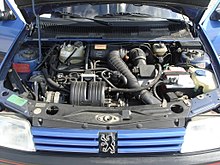
The Peugeot 205 was manufactured with a wide variety of engines. The early versions were equipped with the “Douvrin” engine of the previous model Peugeot 104 , which is also known as the “flat engine” because it “lies” in the engine compartment, with the gearbox in the oil pan below. These engines, which produced between 45 and 79 hp with displacements of 1.0 to 1.4 liters, were gradually replaced from 1988 onwards by the newly developed TU engines from the PSA Group . 205 from Spanish and Moroccan plants were manufactured with another type of engine that Peugeot had inherited from the takeover of Simca ( Chrysler Europe ): the G / Y / J series originating from the Simca 1100 , 1308 and Talbot Horizon , with displacements between 1 , 2 and 1.6 liters and with up to 66 kW (90 hp) in the Spanish model 205 GTX.
- XV, XW, XY engines with 1.0 l, 1.1 l or 1.4 l displacement (from 9.83 to 3.89)
- G / Y / J engines from 1.2 to 1.6 liters displacement
- XU petrol engines with 1.6 l or 1.9 liter displacement
- XUD diesel engines with 1.8 or 1.9 liter displacement
- TU petrol engines with 1.1 l or 1.4 l displacement (from 9.88)
| model | Model name | Displacement (cm³) | Power in kW (PS) | Engine designation | Construction period | V-max | 0-100 km / h | Empty weight |
|---|---|---|---|---|---|---|---|---|
| Petrol engines | ||||||||
| 1.0 | 954 | 31 (42) | XV8 | 11 / 86-09 / 87 | ||||
| 1.0 | 954 | 33 (45) | XV8 | 09 / 83-10 / 86 | ||||
| 1.1 | 1124 | 36 (49) | XW7 | 01 / 86-09 / 88 | ||||
| 1.1 | 1124 | 37 (50) | XW7 | 09 / 83-12 / 85 | ||||
| 1.1 | 1124 | 40 (55) | TU1 | 09 / 88-09 / 89 | ||||
| 1.1 | 1124 | 44 (60) | TU1M | 09 / 89-06 / 96 - G-KAT | approx. 164 km / h | 13.9 s | 790 kg | |
| 1.3 | 205 Rally 1.3 (not in Germany) | 1294 | 74 (101) | TU2.4A | 03 / 88-12 / 90 | |||
| 1.4 | 1360 | 44 (60) | XY7 | 09 / 83-03 / 89 | ||||
| 1.4 | 205 CJ G-CAT | 1360 | 44 (60) | TU3CP | 09 / 88-08 / 89 | |||
| 1.4 | 1360 | 49 (67) | TU3A | 04 / 89-08 / 89 | ||||
| 1.4 | 205 XS / GT / CJ / Green / Roland Garros G-KAT | 1360 | 55 (75) | TU3M | 09 / 88-06 / 96 | approx. 175 km / h | 10.6 s | 850 kg |
| 1.4 | 205 XS / GT / CT | 1360 | 58 (79) | XY8 | 01 / 86-03 / 89 | |||
| 1.4 | 205 XS / GT / CT | 1360 | 59 (80) | XY8 | 09 / 83-12 / 85 | |||
| 1.4 | 205 XS / GT / CT (not in Germany) | 1360 | 62 (84) | TU3S | 04 / 89-08 / 89 | |||
| 1.6 | 205 automatic 1.6 | 1580 | 55 (75) | XU51C | 09 / 86-08 / 89 | |||
| 1.6 | 205 automatic 1.6
205 "XS90" G-KAT 205 "GT90" |
1580 | 65 (89) | XU5M3Z | 09 / 91-06 / 96 | 167 km / h
180 km / h 180 km / h |
14 s
10 s 10 s |
880 kg
850 kg 850 kg |
| 1.6 | 205 GTI 1.6 "105 PS" | 1580 | 76 (103) | XU5J | 09 / 83-10 / 85 | about 193 km / h | 8.6 s | 850 kg |
| 1.6 | 205 GTI 1.6 "105 PS" Puls-Air (only for D) | 1580 | 76 (103) | XU5J1 | 11 / 85-08 / 89 | |||
| 1.6 | 205 GTI 1.6 "115 PS" / CTI 1.6 "115 PS" | 1580 | 83 (113) | XU5JA | 11 / 85-02 / 92 | 9.2 s | ||
| 1.8 | Peugeot 205 T16 "200 PS" | 1775 | 147 (200) | XU8 T | 1984 | 209 km / h | 6 s | 1145 kg |
| 1.9 | 205 GTI 1.9 "105 PS" / CTI 1.9 "105 PS" / Rallye 1.9 / Gentry / Automatic 1.9 G-KAT / Open | 1905 | 75 (102) | XU9J1 | 03 / 86-12 / 94 | approx. 185 km / h | approx. 9.6 s (automatic approx. 10.6 s) | |
| 1.9 | 205 GTI 1.9 "120 PS" G-CAT | 1905 | 88 (120) | XU9JAZ | 09 / 88-08 / 95 | approx. 202 km / h | 8.5 s | 880 kg |
| 1.9 | 205 GTI 1.9 "130 PS" (discontinued in Germany from mid-1988) | 1905 | 94 (128) | XU9JA | 09 / 86-02 / 92 | approx. 208 km / h | 7.6 s | 875 kg |
| diesel | ||||||||
| 1.8 diesel | 205 GLD, GRD, SRD (not in Germany since 1989) | 1769 | 44 (60) | XUD7 | 09 / 83-06 / 99 | 155 km / h (GRD) | approx. 15.1 s (GRD) | approx. 930 kg (GRD) |
| 1.8 XTD (turbo diesel) | 205 DTurbo (not in Germany) | 1769 | 58 (79) | XUD7T | 1990-1998 | 175 km / h | 12.2 s | 925 kg |
| 1.9 diesel | 205 XSD / XRD, GLD, GRD, SRD | 1905 | 47 (64), in other markets 44 kW (60 PS) | XUD9Y | 1987-1998 | |||
landing gear
All wheels are individually suspended, the front wheels with rack and pinion steering on MacPherson struts and wishbones , the rear wheels on parallel swing arms with torsion bar springs . The swingarms, springs and shock absorbers sit on a subframe . In order to accommodate the required length of the spring, one spring sits in front of and the other behind the frame tube on which the two swing arms ( trailing arm ) are mounted. The brakes work with disc brakes at the front and drum brakes at the rear, which are hydraulically actuated by a pneumatic brake booster.
Sports models
Compared to the "small" 205 models, the GTI models had a body with some detail changes, including wheel arches with a completely different cut, corresponding wheel arch extensions made of plastic and larger wheels (14 "or 15") to give it a sporty note to emphasize. In addition, other rear axles with a wider track and sometimes disc brakes instead of drum brakes were used.
- GTI 1.6, year 1984–89, 1580 cm³, 76 kW (103 PS)
- GTI 1.6, year of construction 1986–92, 1580 cm³, 83 kW (113 PS), not officially sold in Germany
- GTI 1.9, year of construction 1986–88, 1905 cm³, 75 kW (102 PS), early version with G-Kat for Germany and Switzerland
- GTI 1.9, year of construction 1986–92, 1905 cm³, 94 kW (128 PS), (without catalytic converter) Sale in Germany with the appearance of the 88 kW version (G-KAT) discontinued
- GTI 1.9, model year 1988–95, 1905 cm³, 88 kW (120 hp)
- The 205 GTI “Griffe” (French for “claw”) was a GTI with extensive special equipment (leather, ABS, power steering). painted in the special color "fluorite green". It was built in a limited edition of 3,000 pieces, 1,000 of which were reserved for the French market with the 94 kW / 128 hp engine and without a sliding glass roof (air conditioning was also available as an option). The remaining 2,000 units were destined for export markets and were delivered with the 88 kW / 120 PS engine with a regulated catalytic converter. They can be recognized, among other things, by the fact that they were all built with the large sliding glass roof.
- Rally 1.3: year of construction 1988–91, 1294 cc, 74 kW (101 hp)
- Rally 1.9: year of construction 1988–92, 1905 cm³, 75 kW (102 hp)
- The rally was a very sparsely equipped version of the 205, which was intended directly for amateur motorsport. It was relatively cheap in terms of purchase price and can be recognized by the white standard paintwork and the specific wheel arch extensions.
- Turbo 16 200: built in 1984, 1775 cm³ 147 kW (200 PS)
- STDT: from year of construction 1990, 1769 cm³ 58 kW (79 PS) equipment similar to GTI (wheel arches, seats etc.), but with turbodiesel engine. However, this was never exported to Germany.
Body styles
Cabriolet
- The CTI is the convertible counterpart to the closed GTI, but in contrast to markets such as Japan and Australia, it was not available in Europe with the 120-hp engine.
- CTI 1.6: Bj. 03 / 86-08 / 89 1580 cm³ 76 kW / 104 PS
- CTI 1.6: Bj. 03 / 86-02 / 92 1580 cm³ 83 kW / 113 PS
- CTI 1.9: Bj. 03 / 86–1994, 1905 cm³ 75 kW / 102 PS (cat)
- The XS or the four-door GT can be seen as the brother of the CT , but this model was not very widespread, perhaps due to the simple equipment.
- CT: Bj. 1986–1988, 1360 cm³ 59 kW (80 PS)
- The deliberate counterpart to the CJ is the junior, the jeans-covered seats are particularly striking.
- CJ: Bj. 1987–1988, 1360 cm³ 44 kW (60 PS)
- CJ: Bj. 1988-1994, 1124 cm³ 44 kW (60 PS)
- The Roland Garros was available both with and without a roof, initially it was only available with the TU3M engine with 75 hp, later also with the XU5M 90 hp engine.
- Roland Garros Cabriolet: from year 1991, 1360 cm³ 55 kW (75 PS)
- Roland Garros Cabriolet: from year 1991, 1580 cm³ 66 kW (90 PS)
- The last convertible version was simply called "Cabriolet 205" and had extensive equipment, in addition to the large dashboard also sports seats. However, only one engine with the 75 HP TU3M engine was available. In addition, the last years of construction showed a significantly poorer rust prevention.
Multi
On the basis of the three-door sedan , the manufacturers of special vehicles Gruau and Durisotti produced a simple panel van variant at the end of 1983: the 205 without roof plate received a U-shaped bracket to accommodate a vertical tailgate and a box body made of glass fiber reinforced plastic (GRP), which was flush with the Body was glued and riveted.
Side windows, taillights, rear bumper and locks were taken over unchanged from the sedan. The result was a larger cargo space of 1600 liters (instead of 1015 liters) with the same footprint. Due to the higher weight of the body and the unchanged chassis, the payload was reduced by around 30 kg. The Multi was sold with a 1.1-liter gasoline engine (TU) and as a diesel with initially 1.8, then 1.9 liters.
With the facelift in mid-1990, the step in the roof disappeared in favor of the more aerodynamic shape shown. Nevertheless, the construction cost about 10 km / h top speed. The Multi was sold by Peugeot dealers.
Fourgonnette
In the spring of 1994, a "real" panel van version with a wheelbase extended by 23 cm replaced the Multi. As with the technically related Citroën C15 , a box body began with the B-pillar, although this was not an all-metal construction, but a steel frame with duroplastic paneling. Instead of the tailgate, the 205 F had the split doors of the Citroën C15 . A low loading sill made it easier to use the now 2.6 m³ large loading space, the floor area of which now enabled loading with a Euro pallet .
The 205 F was never a success and Peugeot stopped production in late 1998. On the one hand, the newly introduced panel van could not hold its own against the C15 established in France and Spain (over 1.2 million units sold by 2005) from the same company; on the other hand, a joint successor model came onto the market as early as 1996 with Peugeot Partner and Citroën Berlingo , the was developed from the start as a commercial vehicle.
Turbo 16

The 205 Turbo 16 was a rally vehicle developed for Group B , which no longer had much in common with the series 205, but can be classified as a thoroughbred racing device with attributes such as tubular space frame , all-wheel drive , mid-engine and turbocharging . The FIA regulations for Group B required a minimum of 200 units to be built. So-called evolutionary stages were allowed to be homologated annually, and 20 copies each had to be manufactured and approved. Peugeot first developed the competition version and from it the production vehicle. The 200 series (chassis numbers P1 to P200) was manufactured by Talbot (Simca). All of these vehicles had the same equipment and had an anthracite gray metallic paintwork, with the exception of the very first vehicle (P1), which had the same white paintwork with blue and yellow contrasting color accents as the competition versions and was shown and at the press presentation of the model 205 at the same time as the front-wheel drive high-volume versions was presented as a competitive version. At the same time as this 200 series, 20 evolution models of the first stage were produced by Peugeot Talbot Sport (chassis numbers C1 to C20) and presented to the FIA for homologation on the same day as the series vehicles. In 1985 Peugeot Talbot Sport produced another 20 vehicles of evolution stage 2 (chassis numbers C201 to C220) and homologated. For the 205T16, normal two-door production bodies were taken off the assembly line and were extensively modified by the body builder Heuliez. The entire rear section was cut off and a bulkhead was inserted between the B-pillars of the body. The body has also been shortened and reinforced at the front. Subsequently, extensive reinforcements, roll bars and rear frames were added in a mixed construction of pressed sheet metal box profiles and pipes. These bodies were delivered to the respective production facilities. The box profiles were omitted in the Evo-2 vehicles, where all modifications were made as tubular structures. The shape of the body is based heavily on that of the production model, which was required from the start for marketing reasons. The front and rear of the vehicle are each designed as a single part, which can be completely opened or removed in order to gain access to the mechanics. In terms of output, the competition vehicles were between 255 and almost 380 kW, depending on the stage of development. Its direct competitors include the Lancia Delta S4 , the Audi Sport quattro S1 , the Ford RS200 and the MG Metro 6R4 . Most of these cars have been in the hands of collectors for many years, and a 205 Turbo 16 rarely changes hands.
In 1987 and 1988, 205 Turbo 16s modified beyond the rules of Group B also successfully took part in the Dakar Rally , the Pikes Peak International Hill Climb and up to and including 1992 in the European Rallycross Championships.
Prototypes
There were several proposals for a station wagon for the 205, including by in-house designer Pininfarina , who anticipated the design language of the 405 Break with the prototype .
literature
- Alexander Burden: Peugeot 205: 1983-1998 (Schrader-Types-Chronik) , Motorbuch-Verlag, 2008, ISBN 978-3-613-03054-1 .
- Jean Todt : 205 - History of a Challenge , Motorbuch-Verlag, Stuttgart 1985, ISBN 2-08-201818-0 . (Note: history of the Peugeot 205 in rallying) [1]
Web links
- Picture gallery 25 years Peugeot 205 - autozeitung.de
- Used car test Peugeot 205 - autobild.de
- Special body 205 F (French)
- Special body 205 Multi (French)
- Website of the special model 205 Gti Radio 1 FM (English)
Individual evidence
- ↑ http://www.autobild.de/artikel/peugeot-208-gti-peugeot-205-turbo-16-vergleich-11034975.html
- ↑ Final report - environmental bonus. (PDF; 1.6 MB) Federal Office for Economics and Export Control and Federal Motor Transport Authority, November 1, 2010, accessed on July 26, 2014 .
- ↑ AUTOMOBILES: The miracle of technology - DER SPIEGEL 46/1985
| Timeline of the Peugeot models since 1945 | ||||||||||||||||||||||||||||||||||||||||||||||||||||||||||||||||||||||||||||
|---|---|---|---|---|---|---|---|---|---|---|---|---|---|---|---|---|---|---|---|---|---|---|---|---|---|---|---|---|---|---|---|---|---|---|---|---|---|---|---|---|---|---|---|---|---|---|---|---|---|---|---|---|---|---|---|---|---|---|---|---|---|---|---|---|---|---|---|---|---|---|---|---|---|---|---|---|
| Type | 40s | 50s | 60s | 70s | 80s | 90s | 2000s | 2010s | 2020s | |||||||||||||||||||||||||||||||||||||||||||||||||||||||||||||||||||
| 5 | 6th | 7th | 8th | 9 | 0 | 1 | 2 | 3 | 4th | 5 | 6th | 7th | 8th | 9 | 0 | 1 | 2 | 3 | 4th | 5 | 6th | 7th | 8th | 9 | 0 | 1 | 2 | 3 | 4th | 5 | 6th | 7th | 8th | 9 | 0 | 1 | 2 | 3 | 4th | 5 | 6th | 7th | 8th | 9 | 0 | 1 | 2 | 3 | 4th | 5 | 6th | 7th | 8th | 9 | 0 | 1 | 2 | 3 | 4th | 5 | 6th | 7th | 8th | 9 | 0 | 1 | 2 | 3 | 4th | 5 | 6th | 7th | 8th | 9 | 0 | |
| Microcar | ion | |||||||||||||||||||||||||||||||||||||||||||||||||||||||||||||||||||||||||||
| 106 | 107 | 108 | ||||||||||||||||||||||||||||||||||||||||||||||||||||||||||||||||||||||||||
| Small car | 104 | 205 | 206 | |||||||||||||||||||||||||||||||||||||||||||||||||||||||||||||||||||||||||
| 202 | 207 | 208 I. | 208 II | |||||||||||||||||||||||||||||||||||||||||||||||||||||||||||||||||||||||||
| Compact class | 204 | 301 | ||||||||||||||||||||||||||||||||||||||||||||||||||||||||||||||||||||||||||
| 203 | 304 | 305 | 306 | 307 | 308 I. | 308 II | ||||||||||||||||||||||||||||||||||||||||||||||||||||||||||||||||||||||
| Lower middle class | 309 | 408 I. | 408 II | |||||||||||||||||||||||||||||||||||||||||||||||||||||||||||||||||||||||||
| Middle class | 403 | 404 | 405 | 406 | 407 | |||||||||||||||||||||||||||||||||||||||||||||||||||||||||||||||||||||||
| 505 | 508 I. | 508 II | ||||||||||||||||||||||||||||||||||||||||||||||||||||||||||||||||||||||||||
| upper middle class | 504 | |||||||||||||||||||||||||||||||||||||||||||||||||||||||||||||||||||||||||||
| 604 | 605 | 607 | ||||||||||||||||||||||||||||||||||||||||||||||||||||||||||||||||||||||||||
| Coupe | RCZ | |||||||||||||||||||||||||||||||||||||||||||||||||||||||||||||||||||||||||||
| 404 coupe | 504 coupe | 406 coupe | 407 coupe | |||||||||||||||||||||||||||||||||||||||||||||||||||||||||||||||||||||||||
| Minivan | 1007 | |||||||||||||||||||||||||||||||||||||||||||||||||||||||||||||||||||||||||||
| Crossover | 2008 I. | 2008 II | ||||||||||||||||||||||||||||||||||||||||||||||||||||||||||||||||||||||||||
| 3008 I. | ||||||||||||||||||||||||||||||||||||||||||||||||||||||||||||||||||||||||||||
| SUV | 3008 II | |||||||||||||||||||||||||||||||||||||||||||||||||||||||||||||||||||||||||||
| 4008 | ||||||||||||||||||||||||||||||||||||||||||||||||||||||||||||||||||||||||||||
| 4007 | ||||||||||||||||||||||||||||||||||||||||||||||||||||||||||||||||||||||||||||
| 5008 II | ||||||||||||||||||||||||||||||||||||||||||||||||||||||||||||||||||||||||||||
| Compact van | 5008 I. | |||||||||||||||||||||||||||||||||||||||||||||||||||||||||||||||||||||||||||
| Van | 806 | 807 | ||||||||||||||||||||||||||||||||||||||||||||||||||||||||||||||||||||||||||
| Off-road vehicle | P4 | |||||||||||||||||||||||||||||||||||||||||||||||||||||||||||||||||||||||||||
| Pick up | 403 truck | 404 pick up | 504 pick up | Pick up | Land trek | |||||||||||||||||||||||||||||||||||||||||||||||||||||||||||||||||||||||
| High roof combination | Traveler | |||||||||||||||||||||||||||||||||||||||||||||||||||||||||||||||||||||||||||
| Box van | 205 Multi / Fourgonnette | |||||||||||||||||||||||||||||||||||||||||||||||||||||||||||||||||||||||||||
| Bipper | ||||||||||||||||||||||||||||||||||||||||||||||||||||||||||||||||||||||||||||
| partner | partner | Rifter | ||||||||||||||||||||||||||||||||||||||||||||||||||||||||||||||||||||||||||
| Transporter | D3 | D4 | J7 | J9 | Expert | Expert | Expert | |||||||||||||||||||||||||||||||||||||||||||||||||||||||||||||||||||||
| J5 | boxer | boxer | ||||||||||||||||||||||||||||||||||||||||||||||||||||||||||||||||||||||||||
|
|
||||||||||||||||||||||||||||||||||||||||||||||||||||||||||||||||||||||||||||
| Timeline of the Peugeot models from 1889 to 1944 | ||||||||||||||||||||||||||||||||||||||||||||||||||||||||
|---|---|---|---|---|---|---|---|---|---|---|---|---|---|---|---|---|---|---|---|---|---|---|---|---|---|---|---|---|---|---|---|---|---|---|---|---|---|---|---|---|---|---|---|---|---|---|---|---|---|---|---|---|---|---|---|---|
| Type | 1880s | 1890s | 1900s | 1910s | 1920s | 1930s | 1940s | |||||||||||||||||||||||||||||||||||||||||||||||||
| 9 | 0 | 1 | 2 | 3 | 4th | 5 | 6th | 7th | 8th | 9 | 0 | 1 | 2 | 3 | 4th | 5 | 6th | 7th | 8th | 9 | 0 | 1 | 2 | 3 | 4th | 5 | 6th | 7th | 8th | 9 | 0 | 1 | 2 | 3 | 4th | 5 | 6th | 7th | 8th | 9 | 0 | 1 | 2 | 3 | 4th | 5 | 6th | 7th | 8th | 9 | 0 | 1 | 2 | 3 | 4th | |
| Small car | 1 | 2 | 3 / 4 | 5 / 6 / 7 / 8 | 21 / 24 / 30 / 31 | 37 | 54 | 57 | 69 "Bébé" | B P1 / B3 / P1 "Bébé" [1] | 161/172 "Quadrilette" | 190 | ||||||||||||||||||||||||||||||||||||||||||||
| 26 / 27 / 28 | 48 | 126 | 201 | 202 ... | ||||||||||||||||||||||||||||||||||||||||||||||||||||
| Compact class | 14 / 15 / 25 | 56 | 58 | 68 | VA / VC / VY [1] | V2C / V2Y [1] | VD / VD2 [1] | 159 | 163/163 BS | 301 | 302 | |||||||||||||||||||||||||||||||||||||||||||||
| 33 / 36 | 63 | 99 | 108 | 118 | 125 | 173 / 177 / 181 / 183 | ||||||||||||||||||||||||||||||||||||||||||||||||||
| Middle class | 9 / 10 / 11 / 12 | 16 / 17 / 19 / 32 | 49/50 | 65/67 | 77 | 78 | 88 | 127 | 143 | 153 | 153 B / BR | 176 | 401 | 402 | ||||||||||||||||||||||||||||||||||||||||||
| 18th | 39 | 61 | 71 | 81 | 96 | 106 | 116 | 126 | 138 | 175 | ||||||||||||||||||||||||||||||||||||||||||||||
| upper middle class | 23 | 42/43/44 | 62 | 72 | 82 | 92 | 104 | 112/117/122/130/134 | 139 | 145/146/148 | 174 / 184 | 601 | ||||||||||||||||||||||||||||||||||||||||||||
| 66 | 76 | 83 | 93 | 135 | 156 | |||||||||||||||||||||||||||||||||||||||||||||||||||
| Upper class | 80 | 103 | 113 | 141 | 147/150 | |||||||||||||||||||||||||||||||||||||||||||||||||||
| 85 | 95 | 105 | ||||||||||||||||||||||||||||||||||||||||||||||||||||||
| Convertible / Spider | 91 | 101/120 | 133 / 111/129/131 | 136 | 144 | |||||||||||||||||||||||||||||||||||||||||||||||||||
| Box van | 13 | 22nd | 34/35 | |||||||||||||||||||||||||||||||||||||||||||||||||||||
| minibus | 20 / 29 | 107 | ||||||||||||||||||||||||||||||||||||||||||||||||||||||
